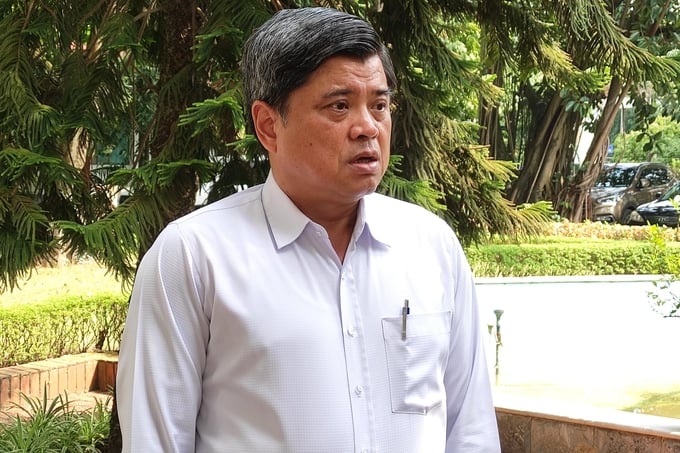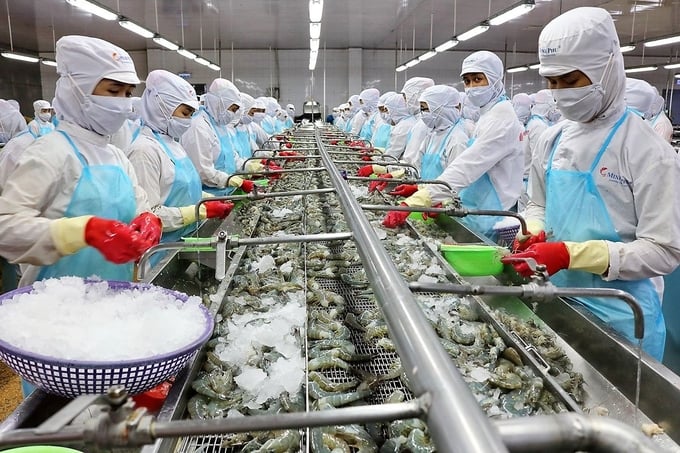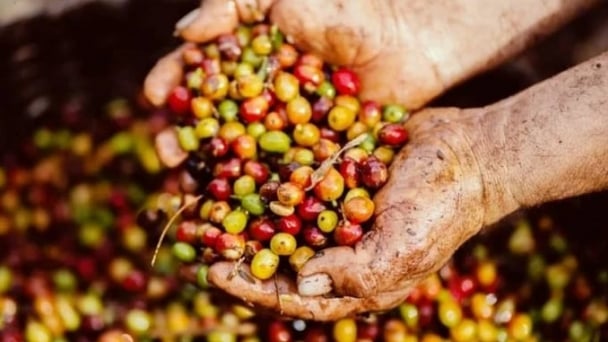June 18, 2025 | 13:11 GMT +7
June 18, 2025 | 13:11 GMT +7
Hotline: 0913.378.918
June 18, 2025 | 13:11 GMT +7
Hotline: 0913.378.918

Deputy Minister of Agriculture and Rural Development Tran Thanh Nam.
Vietnam Agriculture News has recently had an interview with Deputy Minister of Agriculture and Rural Development Tran Thanh Nam so that our dear viewers can have a clearer view of this matter.
Dear Deputy Minister, could you tell us about the potential of using by-products in the fields of agroproduction at present?
Vietnam’s agriculture in the past few years has attained a strong transformation. Agroproduction moves towards market demand, bringing high product quality and added value, the situation however comes with an abundance of by-products. People mention the risks of polluting the environment and wasting organic matter.
If this resource can be exploited and used well, not only we can contribute to resolving the problems above, but it will become a great benefit in terms of economic efficiency. The total amount of agricultural by-products in Vietnam is estimated at 160 million tons, of which approximately 90 million tons are post-harvested by-products from crops and the agro-processing industry (accounting for 56.2 %); 62 million tons of cattle and poultry manure from the livestock industry (accounting for 38.7%); 6 million tons from the forestry sector (accounting for 3.7%) and 1 million tons from the fisheries sector (0.6%). These numbers show the valuable potential of agricultural by-product utilization.
So how is the current usage of by-products? Are there some clear signs of it as a renewable resource?
With the State’s development policy orientation, there has been a positive change in the perception of producers and traders. Along with the development of science, technology and the market, agricultural by-products are gradually becoming a true resource – an important input for the production of many other fields.
Cultivation by-products are used to produce pellets, industrial alcohol, biomass power. It also serves as a biological buffer for livestock and organic fertilizer for clean agroproduction. Livestock waste is managed in a variety of ways, including composting, microbial product treatment, and biogas plants. In many places fresh manure is used directly as fertilizer. Every year the biomass by-products from main crops such as rice, maize, sugarcane, vegetables of all kinds provide a huge source of nutrition for the soil as well.
Meals of all types (meat, bone, poultry, feather, etc.) and animal fat are the main products of the processing and animal feed industry. Nearly 90% of fishery by-products have been collected and processed into valuable products for feed production or into higher-value products such as collagen and instant food.
However, it can be seen that The use of agricultural by-products is still not synchronized and efficient, leaving a large amount of waste. We have not yet created high added value products and have not built a reputable brand in the market through this resource. This problem is also posing the need for mechanisms and solutions to promote the circular link between livestock and farming establishments to create a closed procedure.
Now many models are using agricultural by-products as a true renewable resource. Would you like to share more about the value obtained from these models?
Looking from reality, cooperatives and businesses have had many good models applying the circular economy principle associated with green growth, using by-products in agriculture, forestry and fishery as renewable resources.
Cooperatives and farmer households have treated rice straw in the field with biological products and used it as fertilizer instead of buying NPK fertilizers. And even without isolation time they still prevent organic poisoning caused by straw, greatly reducing the amount of fertilizers and pesticides required.
In the fishery sector, many companies process by-products into high-value products. Vinh Hoan JSC, Vietnam Food JSC (VNF), and Sao Mai JSC have invested in modern technology to process seafood by-products into fish meal, collagen, gelatin and snack from pangasius skin, cooking oil from pangasius fat. These materials are consumed domestically and abroad.
The seafood by-product processing industry in our country only reaches about USD 275 million in 2020, but if the by-products of nearly 1 million tons of the fishery industry are fully exploited with high technologies, it is possible to earn USD 4 - 5 billion – quite a big value.

By-products in the fishery processing industry can be used as raw materials for many other products. Photo for illustrative purposes.
By identifying agricultural by-products as high-value resources, and developing circular economy, what are the opportunities and challenges in the coming period?
Regarding agroproduction, we have only focused on increasing productivity and output, not paying much attention to the excess amount of input in the process. Inorganic fertilizers and pesticides overuse in cultivation and increase of waste from livestock are threatening the quality of the environment.
Faced with the challenges of environmental pollution and resource-intensive agroproduction, the future of Vietnam’s agriculture needs to rely on knowledge and technology to develop circular agriculture, which has become the development trend in many countries in the world in recent years.
What solutions does the Ministry of Agriculture and Rural Development have to support and promote the effective use of agricultural by-products?
The Ministry of Agriculture and Rural Development will organize a preliminary review of the three-year implementation of Decree 109 of the Government on organic agriculture; implement the Prime Minister's Decision No. 855 approving the 2020-2030 Organic Agriculture Development Scheme with the goal of developing organic agriculture with high added value, sustainable, eco-friendly, associated with circular agro-economy in service of domestic consumption and export.
The Ministry will organize a number of scientific seminars related to the concepts of circular economy, green growth, ecological agriculture, and agro-economy. The ultimate goal is to raise awareness and change the overall mindset in the process of implementing the agroproduction value chain.
In the immediate future, the Ministry assigns the National Agricultural Extension Center science and technology programs to serve new rural construction. Functional units of the Ministry will also develop programs integrated into plans concerning production and the transfer of science and technology related to organic and circular agriculture. These plans will be disseminated to production households, farms, cooperative groups, cooperatives and businesses.
Thank you, sir!
Translated by Samuel Pham
![Turning wind and rain into action: [8] Real-time salinity detection and early warning technology](https://t.ex-cdn.com/nongnghiepmoitruong.vn/608w/files/news/2025/06/17/z6704423696987_15fd32ffc26d590d204d520c9dac6786-nongnghiep-151127.jpg)
(VAN) Thanks to the integration of modern hydrological-hydraulic models, remote sensing technologies, and artificial intelligence, the accuracy of hydrological forecasting has significantly improved.
![Turning wind and rain into action: [7] Early disaster warnings help marine farmers minimize losses](https://t.ex-cdn.com/nongnghiepmoitruong.vn/608w/files/news/2025/06/17/z6704423696987_15fd32ffc26d590d204d520c9dac6786-nongnghiep-142942.jpg)
(VAN) In recent years, thanks to early disaster warnings and forecasting, marine farmers in Khanh Hoa province have been able to reduce risks and losses, thereby improving production efficiency.
![Turning wind and rain into action: [6] ‘Four on-the-spot’ disaster management software](https://t.ex-cdn.com/nongnghiepmoitruong.vn/608w/files/news/2025/06/17/e5a48259d6a262fc3bb3-nongnghiep-183800.jpg)
(VAN) By simply activating the scenario on the disaster management software, the relevant authorities immediately know how many households need to be evacuated, where to evacuate them to, and by what means of transportation…
![Turning wind and rain into action: [5] Hue applies modern technology in disaster forecasting](https://t.ex-cdn.com/nongnghiepmoitruong.vn/608w/files/news/2025/06/17/z6704423696987_15fd32ffc26d590d204d520c9dac6786-nongnghiep-093938.jpg)
(VAN) In Hue city, modern technology has recently been applied in meteorological and hydrological forecasting and warning, helping to reduce the damage caused by natural disasters.

(VAN) A cutting-edge farming technique being implemented on an experimental ranch in Arizona's Sonoran Desert has already saved a billion gallons of water over five years, according to Civil Eats.

(VAN) Poultry and pig production and the environment can be boosted through enhanced water technology, according to new research.

(VAN) Coffee prices on June 16, 2025 are unchanged. In Vietnam, local trading prices are holding steady, ranging around VND 112,000 – VND 112,500/kg.